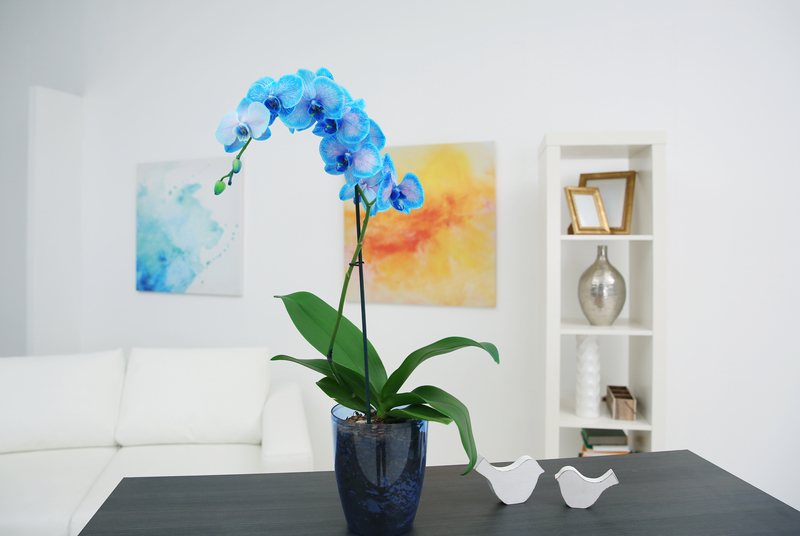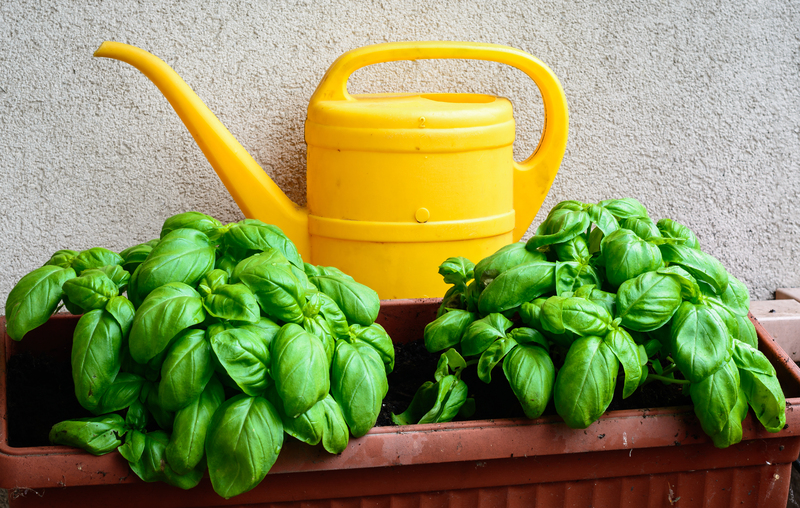The Beauty and Benefits of Vertical Gardening
Posted on 03/09/2025
The Beauty and Benefits of Vertical Gardening
Vertical gardening is taking the world by storm, transforming the way we view and interact with plants in urban and suburban environments. As cities rise and yards shrink, the creativity to bring more greenery into our lives has inspired gardeners of all skill levels. In this article, we'll explore the reasons why vertical gardens are valued, how they enhance aesthetics and functionality, and key tips for cultivating your own skyward oasis. Continue reading to discover the myriad advantages and delights of vertical gardening.

What Exactly Is Vertical Gardening?
At its core, a vertical garden is a garden that grows upwards instead of outwards. Rather than planting in traditional beds or pots spread across the ground, vertical gardening utilizes walls, fences, trellises, or other structures to vertically display a range of plants. This practice integrates both indoor and outdoor spaces, turning plain surfaces into lush, living works of art.
- Wall-mounted planter pockets
- Hanging shelves or stacking modules
- Trellis systems for climbing plants
- Green screens and living walls
- Upcycled pallets and creative containers
The Roots of Vertical Gardening
While the concept may seem modern, vertical gardens have a rich history. The Hanging Gardens of Babylon--one of the Seven Wonders of the Ancient World--were early examples of cultivating plants on elevated terraces. Today, innovative technology and urban space constraints have spurred a renaissance in vertical garden systems.
The Benefits of Vertical Gardening
Why are vertical gardens so appealing? The answer lies in their substantial environmental, aesthetic, and practical advantages. Let's delve into the top benefits that make vertical gardens an irresistible choice for homes, businesses, and public spaces alike.
1. Space Maximization
If you live in an apartment or have limited yard space, growing upwards allows you to have a flourishing garden even in small areas. Vertical gardening solutions make use of otherwise under-utilized vertical spaces such as balcony walls, building facades, or fence lines.
- Grow herbs, flowers, or vegetables even in tight patios.
- Perfect for urban dwellers and renters.
- Makes use of corners, balconies, or room dividers indoors.
2. Improved Air Quality
Many plants are natural air purifiers. By clustering more foliage vertically, you maximize the filtering effect, reducing airborne toxins and increasing your immediate oxygen supply. Living walls help decrease urban heat and pollution, making them valuable additions to city environments and indoor offices.
3. Enhanced Privacy and Sound Insulation
Vertical plantings can act as natural green screens, creating privacy in tight quarters. Dense foliage absorbs noise, softening sounds from streets or neighbors. This dual function provides a peaceful refuge while beautifying your space.
4. Energy Efficiency
Installing vertical gardens on exterior walls can act as natural insulation. Plants block sunlight, keeping buildings cooler in the summer and reducing energy bills. In winter, they provide an added buffer against wind and cold. The result? A more sustainable, energy-efficient property.
5. Beautiful Aesthetics and Living Art
Perhaps the most obvious benefit is visual beauty. Vertical gardens instantly elevate curb appeal and bring life to bland concrete or brick surfaces. Their lush, cascading forms serve as living art, inspiring creativity and a sense of tranquility for all who encounter them.
Types of Vertical Gardening Systems
Choosing the right vertical garden system depends on your space, goals, and plant preferences. Here are some popular methods:
1. Wall-Mounted Living Walls
Also known as green walls, these systems use modular panels or pockets attached to walls. They're an excellent way to brighten interior or exterior walls and can accommodate a variety of plant species from succulents to lush ferns.
Pros:- Striking visual effect.
- Air purification benefits.
- Customizable shapes and sizes.
- Require adequate wall support.
- Maintenance and irrigation considerations.
2. Freestanding Vertical Gardens
These portable units can be placed anywhere, ideal for renters or those wanting flexibility. Freestanding structures often utilize stacked containers or modular bricks.
Benefits:- Easy to move and reconfigure.
- No wall installation required.
- Good for growing vegetables and herbs.
3. Trellis & Climbing Plant Structures
A classic choice, trellises support vines and climbing plants like tomatoes, peas, beans, or flowering clematis. These vertical elements can be incorporated in gardens, patios, or balconies for both functionality and elegance.
4. Hanging Pots and Tiered Shelves
For a simple DIY approach, stack pots or use shelves to create a tiered vertical display. Hanging baskets can be suspended from walls, fences, or ceilings for compact gardening anywhere.
Best Plants for Vertical Gardening
The key to a thriving vertical garden is choosing plants that suit your light and care conditions. Here are some excellent options:
- Herbs: Basil, mint, thyme, oregano, parsley
- Leafy Greens: Lettuce, spinach, arugula, kale
- Climbers: Tomatoes, cucumbers, peas, beans, morning glories
- Succulents: Sedum, echeveria, crassula (require little water)
- Flowers: Petunias, violets, nasturtiums, fuchsias
- Ferns and Mosses: Excellent for shaded or indoor walls
For indoor vertical gardens, consider low-light tolerant plants such as pothos, philodendron, or snake plants. For outdoor installations, sun-loving species will offer the best results.
How to Start Your Own Vertical Garden: Step-by-Step Guide
Step 1: Assess Your Space
Determine where your vertical garden system will live. Consider:
- Amount of sunlight
- Humidity and wind exposure
- Structural support (for mounted systems)
- Accessibility for watering and maintenance
Step 2: Choose Your Vertical Gardening Method
Select a system that suits your location and skill level. Modular panels are great for walls, while planter towers or hanging baskets fit balconies and patios. DIY enthusiasts may prefer crafting their own containers or repurposing materials like wooden pallets.
Step 3: Select Appropriate Plants
Opt for plants that will thrive in your chosen spot. Mix and match for a visually striking display--combine trailing vines, upright growers, and textured foliage for maximum impact.
Step 4: Set Up Support and Install Irrigation (if needed)
Install any mounting hardware with care, ensuring everything is secure. For large living walls, consider a drip irrigation system or self-watering planters to ensure consistent hydration, especially in sunny and dry conditions.
Step 5: Plant and Maintain
Arrange your plants with the tallest or trailing varieties at the top and compact types below. Regularly check soil moisture, prune overgrown foliage, and fertilize as needed. Watch for pests, especially in dense plantings.
Creative Ideas for Attractive Vertical Gardens
Looking to go beyond basics? Try these designs to make your vertical gardening space even more alluring:
- Edible Walls: Create a kitchen garden with rows of herbs and salad greens--snip ingredients right from your living wall!
- Pollinator Havens: Plant flowering species that attract bees and butterflies, boosting local biodiversity.
- Artistic Green Murals: Mix colors and leaf shapes to design living murals. Use brightly colored pots or geometric patterns for added interest.
- Recycled Containers: Upcycle shoe organizers, plastic bottles, or gutters as unique vertical planters.
- Indoor Plant Walls: Transform a living room or office by covering a statement wall with lush greenery--add grow lights for optimal health.
Tips for Successful Vertical Gardening
- Watering: Vertical structures dry out more quickly than ground beds. Install a drip irrigation system or check moisture levels frequently.
- Light: Match plant selection to available sunlight; rotate plants occasionally for even growth.
- Feeding: Use high-quality potting mix and fertilize as needed, since nutrients wash out faster in vertical planters.
- Support: Secure tall or heavy plants with ties. Monitor structures for signs of stress, especially after storms.
- Pruning: Trim regularly for best shape, airflow, and to prevent overcrowding.
Environmental Impact of Vertical Gardens
Beyond personal satisfaction, vertical gardening contributes profound benefits to your local ecosystem:
- Reduces urban heat islands by shielding buildings from direct sunlight
- Improves overall biodiversity with more habitat for insects, birds, and pollinators
- Cleans air by absorbing dust, carbon dioxide, and other pollutants
- Captures rainwater, mitigating runoff and soil erosion
- Boosts food security and health by providing fresh, homegrown produce

Frequently Asked Questions about Vertical Gardening
Is vertical gardening suitable for beginners?
Absolutely! Many systems are designed for easy installation and maintenance. Start with herbs or low-maintenance plants if you're new, and gradually expand your collection.
How much maintenance does a vertical garden require?
While vertical gardens do require regular watering and occasional feeding, modern solutions--like self-watering planters--can make care easier than ever. Prune and monitor for pests just as you would with any garden.
Can I grow vegetables in a vertical garden?
Yes! Many leafy greens, cherry tomatoes, beans, and even compact squash or cucumbers thrive on trellises or in modular planters.
Conclusion: Experience the Joy of Vertical Gardening
Whether you're a city dweller eager to reconnect with nature or a homeowner looking to maximize your green space, the beauty and benefits of vertical gardening are undeniable. It offers an efficient, sustainable, and gorgeous way to enjoy plants, transform spaces, and contribute positively to the environment. Start your own vertical oasis and watch your world grow--upwards!
Explore vertical gardening today and let your creativity, health, and love for nature soar!



